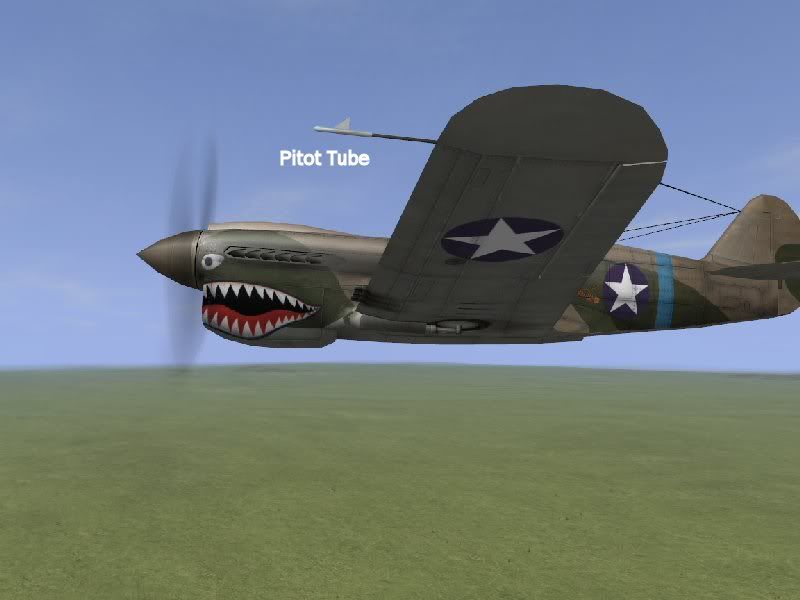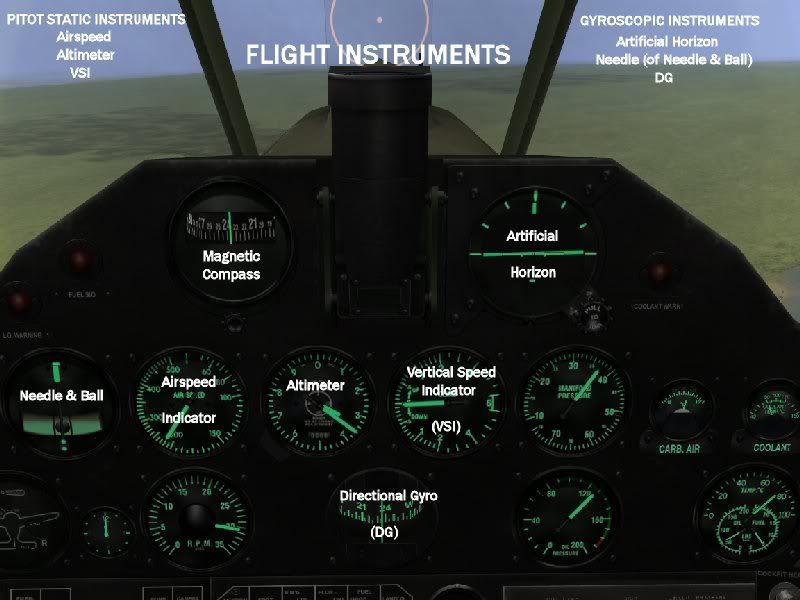Aircraft Instrumentation - Flight Instruments
Posted: 03 Dec 2008, 07:26
After last nights mission and listening to some of the problems people were having, I have decided to post some items that may help you guys get more out of the planes we fly.
This is from the flight training section over at the 352nd VFG that I also am flying with. Rambling Jack is the training guy and he's a current charter pilot flying in Nevada. Its good advice and has helped me get more out of the planes. The following was written by him.
-------------------------------------------------------------------
Aircraft Instrumentation
Aircraft instruments can be categorized into three main groups. These groups are made up of flight instruments, engine instruments, and navigation instruments. The instruments and instrument panel we will discuss are those associated with the P-40E. The information displayed is universal to all airplanes just displayed differently in different airplanes. In modern day airplanes the instrument panel layout is standardized making transitioning from one airplane to another relatively simple. World War II generation aircraft had no such standardization and instruments were placed in the instrument panel based on where they fit and not necessarily where they were most visible.
Flight Instruments
Flight instruments can be further broken down into two groups. They are pitot, (pronounced pee-toe) static instruments and gyroscopic instruments. Pitot static instruments include the airspeed, altimeter, and VSI (vertical speed indicator). Gyroscopic instruments include the artificial horizon, directional gyro (DG), and the needle portion of the needle and ball instrument. Pitot static instruments derive there information by measuring ram air pressure and changes is pressure associated with the airplane climbing or descending. The airspeed, altimeter, and VSI instruments are all plumbed together and comprise the pitot static system. That funny looking probe that is located out on the wing of the airplane is the Pitot tube. In order for the system to work there must also be a static port located somewhere on the airplane where the airflow around the airplane is not disturbed.

As the airplane moves through the air, air enters the pitot tube and puts pressure (dynamic) on a diaphragm inside the airspeed indicator. The other side of the diaphragm is vented to the pitot static port and the difference between dynamic and static pressure is mechanically measured by the airspeed indicator and registered as airspeed. There are three different types airspeeds, indicated airspeed (IAS), calibrated airspeed (CAS), and true airspeed (TAS). It is beyond the scope of this discussion to get into the different types of airspeed, as far as you are concerned, what you see is what you get.
The altimeter is nothing more than an aneroid barometer that registers changes in atmospheric pressure as the airplane climbs and descends. These pressure changes are mechanically registered on the altimeter and give you altitude above mean sea level (MSL). The altimeter does not give you altitude above ground level (AGL). It too is plumbed into the static port and air pressure entering and escaping this port is how it senses the changes in altitude.
The VSI is similar to the altimeter in that it is plumbed into the static port and registers changes in pressure as the airplane climbs and descents. The difference being, that the VSI has a small calibrated aperture that measures the rate at which the pressure changes. This rate of change is registered mechanically as rate of climb or descent in feet per minute.
These three instruments are not dependent on anything other than sensing air pressure changes. They require no electrical power and are not driven by any outside source. Aside from the mechanical gearing within each instrument or the fact that either the pitot tube or static port could become blocked, there is nothing to fail the instruments.

These instruments are vital to flying on instruments should outside references become lost such as in the clouds or on a dark and stormy night. However, in and of themselves you could never fly blind with just the pitot static instruments. Stop and think about the information they provide. It has to do with going up or down and forward. They give you no indication as to whether you are right side up or up side down. You would however see an increase in airspeed and a decrease in altitude if you were diving toward the ground, you just wouldn’t know what side was up. With regards to instrument flying, all three of these instruments give you pitch information. Pitch being determined by the nose of the airplane being above or below the horizon. If the nose is pitched up, the airspeed decreases, the altitude increases, while a rate of climb will be indicated. The opposite would be true if the nose of the airplane was pitched down.
Gyroscopic instruments are comprised of the artificial horizon, the directional gyro (DG), and the needle and ball instrument. The artificial horizon, as the name implies, is a depiction or artificial representation of the outside horizon. The instrument is nothing more than a gyroscope that is spinning at a high rate, usually in the 15,000 to 20,000 rpm range. Due too the physics of a gyroscope’s “rigidity in spaceâ€
This is from the flight training section over at the 352nd VFG that I also am flying with. Rambling Jack is the training guy and he's a current charter pilot flying in Nevada. Its good advice and has helped me get more out of the planes. The following was written by him.
-------------------------------------------------------------------
Aircraft Instrumentation
Aircraft instruments can be categorized into three main groups. These groups are made up of flight instruments, engine instruments, and navigation instruments. The instruments and instrument panel we will discuss are those associated with the P-40E. The information displayed is universal to all airplanes just displayed differently in different airplanes. In modern day airplanes the instrument panel layout is standardized making transitioning from one airplane to another relatively simple. World War II generation aircraft had no such standardization and instruments were placed in the instrument panel based on where they fit and not necessarily where they were most visible.
Flight Instruments
Flight instruments can be further broken down into two groups. They are pitot, (pronounced pee-toe) static instruments and gyroscopic instruments. Pitot static instruments include the airspeed, altimeter, and VSI (vertical speed indicator). Gyroscopic instruments include the artificial horizon, directional gyro (DG), and the needle portion of the needle and ball instrument. Pitot static instruments derive there information by measuring ram air pressure and changes is pressure associated with the airplane climbing or descending. The airspeed, altimeter, and VSI instruments are all plumbed together and comprise the pitot static system. That funny looking probe that is located out on the wing of the airplane is the Pitot tube. In order for the system to work there must also be a static port located somewhere on the airplane where the airflow around the airplane is not disturbed.

As the airplane moves through the air, air enters the pitot tube and puts pressure (dynamic) on a diaphragm inside the airspeed indicator. The other side of the diaphragm is vented to the pitot static port and the difference between dynamic and static pressure is mechanically measured by the airspeed indicator and registered as airspeed. There are three different types airspeeds, indicated airspeed (IAS), calibrated airspeed (CAS), and true airspeed (TAS). It is beyond the scope of this discussion to get into the different types of airspeed, as far as you are concerned, what you see is what you get.
The altimeter is nothing more than an aneroid barometer that registers changes in atmospheric pressure as the airplane climbs and descends. These pressure changes are mechanically registered on the altimeter and give you altitude above mean sea level (MSL). The altimeter does not give you altitude above ground level (AGL). It too is plumbed into the static port and air pressure entering and escaping this port is how it senses the changes in altitude.
The VSI is similar to the altimeter in that it is plumbed into the static port and registers changes in pressure as the airplane climbs and descents. The difference being, that the VSI has a small calibrated aperture that measures the rate at which the pressure changes. This rate of change is registered mechanically as rate of climb or descent in feet per minute.
These three instruments are not dependent on anything other than sensing air pressure changes. They require no electrical power and are not driven by any outside source. Aside from the mechanical gearing within each instrument or the fact that either the pitot tube or static port could become blocked, there is nothing to fail the instruments.

These instruments are vital to flying on instruments should outside references become lost such as in the clouds or on a dark and stormy night. However, in and of themselves you could never fly blind with just the pitot static instruments. Stop and think about the information they provide. It has to do with going up or down and forward. They give you no indication as to whether you are right side up or up side down. You would however see an increase in airspeed and a decrease in altitude if you were diving toward the ground, you just wouldn’t know what side was up. With regards to instrument flying, all three of these instruments give you pitch information. Pitch being determined by the nose of the airplane being above or below the horizon. If the nose is pitched up, the airspeed decreases, the altitude increases, while a rate of climb will be indicated. The opposite would be true if the nose of the airplane was pitched down.
Gyroscopic instruments are comprised of the artificial horizon, the directional gyro (DG), and the needle and ball instrument. The artificial horizon, as the name implies, is a depiction or artificial representation of the outside horizon. The instrument is nothing more than a gyroscope that is spinning at a high rate, usually in the 15,000 to 20,000 rpm range. Due too the physics of a gyroscope’s “rigidity in spaceâ€